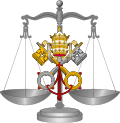Eastern Catholic code of canon law
For Eastern Orthodox canon law, see Canon law of the Eastern Orthodox Church.
The Code of Canons of the Eastern Churches (CCEC; Latin : Codex Canonum Ecclesiarum Orientalium, [1] abbreviated CCEO) is the title of the 1990 work which is a codification of the common portions of the canon law for the 23 Eastern Catholic Churches in the Catholic Church. It is divided into 30 titles and has a total of 1546 canons. [2] The code entered into force in 1991.
Contents
- History
- Language
- Emendations
- Ad Tuendam Fidem
- Mitis et Misericors Iesus
- Competentias quasdam decernere
- Vocare peccatores
- Iam pridem
- Division
- Preliminary canons
- Churches sui iuris and rites
- See also
- Notes
- References
- Bibliography
- External links
The western Latin Church is governed by its own particular code, the 1983 Code of Canon Law.
